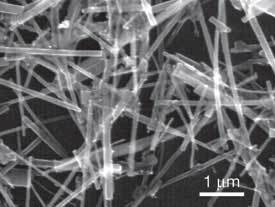| Posted: June 29, 2007 |
Nanowire shines light on subwavelength microscopy |
|
(Nanowerk News) Researchers in the US and Japan have created a nanoscopic 'torch' that shines visible laser light on nanoscale structures, imaging them with high resolution. The system could be developed into a type of microscope for biological applications, suggest the researchers, and might form the basis of a new way to store and process information ("Tunable nanowire nonlinear optical probe").
|
|
Peidong Yang from the Lawrence Berkeley National Laboratory in California and colleagues made nanowires from potassium niobate, KNbO3, which is known to have unusual 'non-linear' optical properties. A single wire, around 100nm across and a few micrometres long, was suspended in an aqueous solution and held in place by beams of infrared laser light acting as optical tweezers.
|
 |
| Potassium niobate nanowires have unusual non-linear optical properties (Copyright: Nature)
|
|
Because of its non-linear optical properties the crystalline nanowire is able to convert the infrared laser light from one frequency to another, making the system tunable - an important property for a range of applications. The researchers showed that the light of modified frequency emerged from the end of the nanowire - similar to a beam of light coming from a torch. They scanned this 'nanotorch' over an object and collected the resulting image in a charge-coupled device, demonstrating that it could distinguish structures of the dimensions of a few tens of nanometres.
|
|
Reporting their findings in Nature, the researchers say: 'We use this tunable nanometric light source to implement a novel form of subwavelength microscopy in which an infrared laser is used to optically trap and scan a nanowire over a sample, suggesting a wide range of potential applications in physics, chemistry, materials science and biology.'
|
|
Rob Eason, of the Optoelectronics Research Centre at the University of Southampton, UK, was impressed by the research. 'The combination of these separate topic areas - growth and characterisation of nonlinear nanowires, optical tweezing, parametric frequency conversion, scanning near field microscopy, and subwavelength measurement - represents some kind of hero experiment,' Eason told Chemistry World. 'Individually each of these topics is a subject in itself, and so in combination is a tour-de-force in my view.'
|
|
However, Eason was less convinced about the claimed potential applications of the research. 'Whether this is set to become a 'routine' application technology as they advertise for all of the physical sciences is, in my view, dubious,' he said.
|

